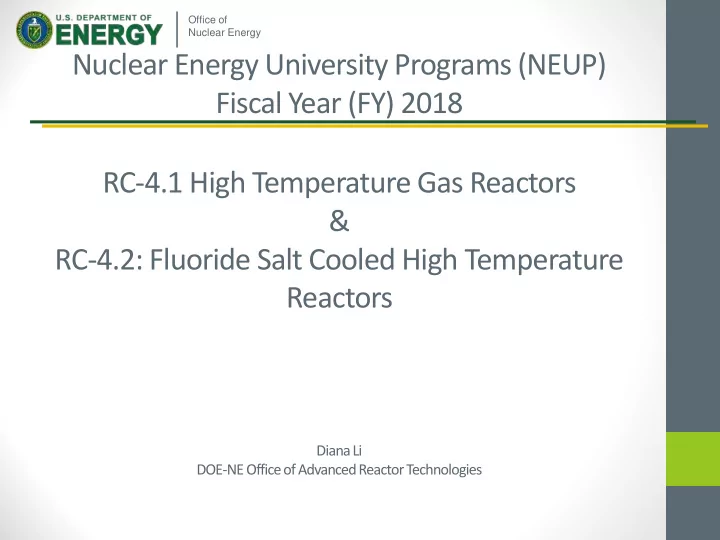

Office of Nuclear Energy Nuclear Energy University Programs (NEUP) Fiscal Year (FY) 2018 RC-4.1 High Temperature Gas Reactors & RC-4.2: Fluoride Salt Cooled High Temperature Reactors Diana Li DOE-NE Office of Advanced Reactor Technologies 1
ART High Temperature Reactor Program • Experimental Validation System and Computational Fluid Dynamics models for high temperature gas reactors lack high quality data for validation Need to understand behavior during loss of forced cooling transients in which decay heat is transported by natural circulation, conduction, and radiation within and from the reactor vessel. This may occur in conjunction with the loss of pressure and coolant inventory resulting from a break in piping or an associated component Validation of models requires completion of separate effect (SET), mixed effect (MET), and integral tests scaled to reproduce the thermal fluid conditions in nominal and accident scenarios General Atomics 350 MWt MHTGR and 600 MWt GT-MHR are reference designs for scaling of experiments 2 2
Federal POC – Diana Li: Diana.LI@nuclear.energy.gov Technical POC – Hans Gougar: Hans.Gougar@inl.gov ART High Temperature Reactor Program Integral testing facilities generally beyond scope of NEUP awards. However, facilities were built using other sources of funding. High Temperature Test Facility (HTTF) Natural circulation Shutdown Test Facility (NSTF) NGNP Alliance and DOE sponsoring investigations of reactor building atmospheric response to primary leaks (an Industry award along with Texas A&M and UltraSafe Nuclear corporation). HTTF and NSTF are scaled to the MHTGR while the Texas A&M/ Ultrasafe study used the GT-MHR as the reference design for scaling. 3 HTTF NSTF 3
Federal POC – Diana Li: Diana.LI@nuclear.energy.gov Technical POC – Hans Gougar: Hans.Gougar@inl.gov RC-4.1 ART High Temperature Reactor Areas of Interest • FY18 focuses on phenomena associated with loss-of-forced-cooling scenarios with or without a break in the primary coolant boundary. • Proposals will be accepted for high fidelity experimental and computational investigation of phenomena: Natural Circulation of hot helium plumes and jets within the reactor vessel during an extended loss of forced circulation Partitioning of water in the primary loop after an SG tube rupture – sensitivity to rupture location • Investigations should include experimental and computational studies of separate and mixed effects associated with HTGR accident phenomena. Proposed scope that includes experimental data will be considered with higher priority than scope that is purely computational. 4 • All experiments must be performed to NQA-1 standards. 4
RC-4.2: Fluoride Salt Cooled High Temperature Reactors • ORNL has a functional high temperature forced-flow FLiNaK salt loop. Additionally, a forced flow FLiBe loop is expected to be available at the beginning of FY19 at ORNL. 5 5
Federal POC – Diana Li: Diana.LI@nuclear.energy.gov RC-4.2: Technical POC – David Holcomb: holcombde@ornl.gov Fluoride Salt Cooled High Temperature Reactors Flow loop testing: • Proposals are requested to design and execute experiments related to: • 1) corrosion • 2) instrumentation demonstration, • 3) thermal-hydraulic data, and/or • 4) dynamic system model verification using the loop(s). The facility(s) would be operated with programmatic funding. Proposals would propose any needed hardware additions to the loop, collect and analyze data, and document the results. 6 6
Federal POC – Diana Li: Diana.LI@nuclear.energy.gov RC-4.2: Technical POC – David Holcomb: holcombde@ornl.gov Fluoride Salt Cooled High Temperature Reactors Reactor core and plant modeling capabilities: • Proposals are also requested for reactor core and plant modeling capabilities that are affordable, accurate, and easily shared among collaborating institutions. Methodologies that provide accurate results while requiring modest computational capability are desirable. Alternate methodologies that provide independent comparison of commonly used methods is highly desirable. Areas of interest include, but are not limited to: • 1) Core neutronics • 2) Thermal hydraulics • 3) Dynamic system level modeling. • All work should be performed to NQA-1 standards. Models that will provide data in a form that can interface with the NEAMS toolkit will be considered with higher priority. 7 7
Recommend
More recommend